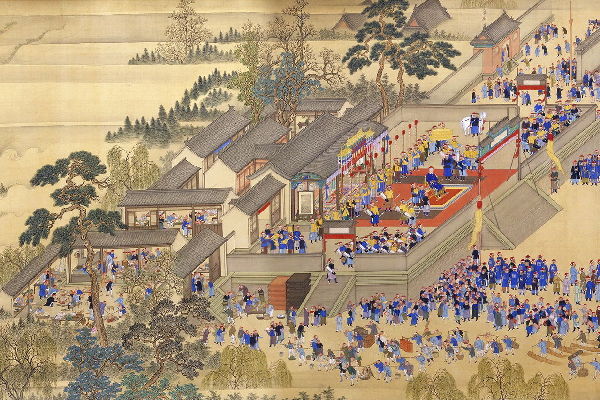A Seat of Power
Updated: 2012-08-14 16:01
(www.chinaculture.org)
|
|||||||||||

The word jiaoyi refers to a folding chair in use in China. Because the shape of its crossed legs resembles the Chinese word "交" (jiao), this chair is named as jiaoyi. Jiaoyi was introduced into central China during the Eastern Han Dynasty (AD 25-220) from the western regions. Due to the chair’s popularity, Han people stopped sitting on the ground and started to sit on the chair.
Because it is collapsible, the jiaoyi came in handy for use in outdoor activities. When an emperor felt tired on a hunting trip, his servants would carry out a jiaoyi for him to rest upon. Gradually, in this way, the use of a jiaoyi had been synonymous with power. Take the picture The Emperor Kangxi Inspecting the South as an example. We can see from the picture that Emperor Kangxi (1654-1722) is sitting on a jiaoyi in the middle of the stage, while others are standing right beside him.
 |
|
The Emperor Kangxi Inspecting the South |
The word jiaoyi is widely used in the Outlaws of the Marsh - one of four great classical novels. The story tells why and how 108 men and women, from different backgrounds, banded together on Liangshan Mountain, and fought battles against government troops, during the Song Dynasty (960-1279). Each of the 108 heroes has his or her jiaoyi.
In the novel, the first jiaoyi is used by the leader Song Jiang. In the following picture, Song Jiang sits in the middle area.

Related Stories
Culture adds muscle to the Olympic experience 2012-08-13 10:44
The rare finds of Beijing Antique Markets 2012-08-09 17:26
Cultural Olympiad brings West Africa art to Britain 2012-08-09 10:28
China-Nepal cultural performance held in Nepal 2012-08-07 10:13
Antique feel, modern appeal 2012-08-06 13:26
Today's Top News
Rescuers race against time for quake victims
Telecom workers restore links
Coal mine blast kills 18 in Jilin
Intl scholarship puts China on the map
More bird flu patients discharged
Gold loses sheen, but still a safe bet
US 'turns blind eye to human rights'
Telecom workers restore links
Hot Topics
Lunar probe , China growth forecasts, Emission rules get tougher, China seen through 'colored lens', International board,
Editor's Picks

|

|

|

|

|

|





